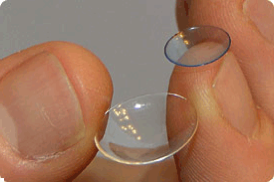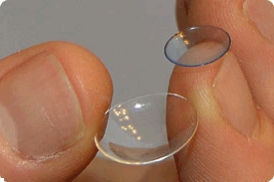MODERN SCLERAL CONTACT LENSES
Scleral contact lenses are the newest class of contact lenses that we use. They are not really new as they have been around for decades. They have come back into use by the creation of new designs, materials and manufacturing capabilities hat have made them more practicable. They can be useful for the management of conditions that create corneal irregularity like keratoconus or pellucid marginal degeneration or post-surgical irregularity after ocular trauma, corneal transplants, or severe dry eyes. Patients that can’t be corrected to normal 20/20 vision can often benefit from these lenses.
Patients whom have been told they are poor candidate r who had had poor vision or comfort may now find that scleral lenses are the solution they may be looking for.
These large-diameter gas permeable (GP) lenses offer the same advantages that conventional GP lenses have compared with soft contacts, including:

- Greater durability
- Easier handling
- Less risk of complications
They are called "scleral" lenses because, instead of covering only a portion of the cornea (like conventional GP lenses), these large GP lenses vault over the entire corneal surface and rest on the "white" of the eye (the sclera).
Because of their size, scleral lenses are more stable on the eye than conventional GP lenses — so they are less likely to accidentally dislodge from the eye. This stability also can make them more comfortable than conventional GP lenses; scleral lenses provide initial comfort similar to soft lenses, especially for sensitive eyes or irregularly shaped corneas.
Types of Scleral Lenses
There are three categories of scleral lenses, based on size and where the lenses have their primary contact with the front surface of the eye:
- Corneo-scleral lenses and semi-scleral lenses are much larger larger than conventional GP lenses and rest near the junction between the cornea and the sclera.
- Mini-scleral lenses vault over the entire corneal surface and rest on the anterior sclera.
- Full scleral lenses are the largest scleral lenses and provide the greatest amount of clearance between the back surface of the lens and the cornea.
Are You a Good Candidate?
Generally, anyone interested in achieving the best vision possible with contact lenses can be a candidate for scleral lenses. But scleral GP lenses are particularly helpful for the following conditions:
- Irregular corneas. Vision problems caused by an irregularly shaped cornea — whether naturally occurring, due to an eye condition such as keratoconus, or resulting from eye surgery — typically cannot be fully corrected with glasses or soft contact lenses. Scleral lenses typically will provide sharper vision for these eyes.
- Hard-to-fit eyes. If your eyes cannot be comfortably fitted with conventional GP lenses or the shape of your eye causes the lenses to dislodge too easily from your eyes (during sports, for example), scleral lenses can provide a more comfortable and secure fit.
- Dry eyes. If your eyes are too dry for conventional contact lenses, scleral lenses can help. In particular, the generous space between the back surface of full scleral lenses and the cornea acts as a tear reservoir to keep the front of your eye more moist and comfortable.
Cost of Scleral Lenses
Scleral lenses are custom-made to the exact specifications by our doctors to provide the best possible vision, eye health and comfort.
Also, special automated measuring tools and imaging devices are used to fit scleral lenses, and these instruments typically are not required for fitting soft lenses. The initial fitting to obtain the proper fit is much more labour intensive and chair time is a factor.
For these reasons, professional fees associated with fitting scleral lenses and lens replacement costs are higher for scleral lenses than other contact lenses.
In some cases, vision insurance may cover a portion of the costs associated with scleral lenses.
 Vision Center Direct
Vision Center Direct


